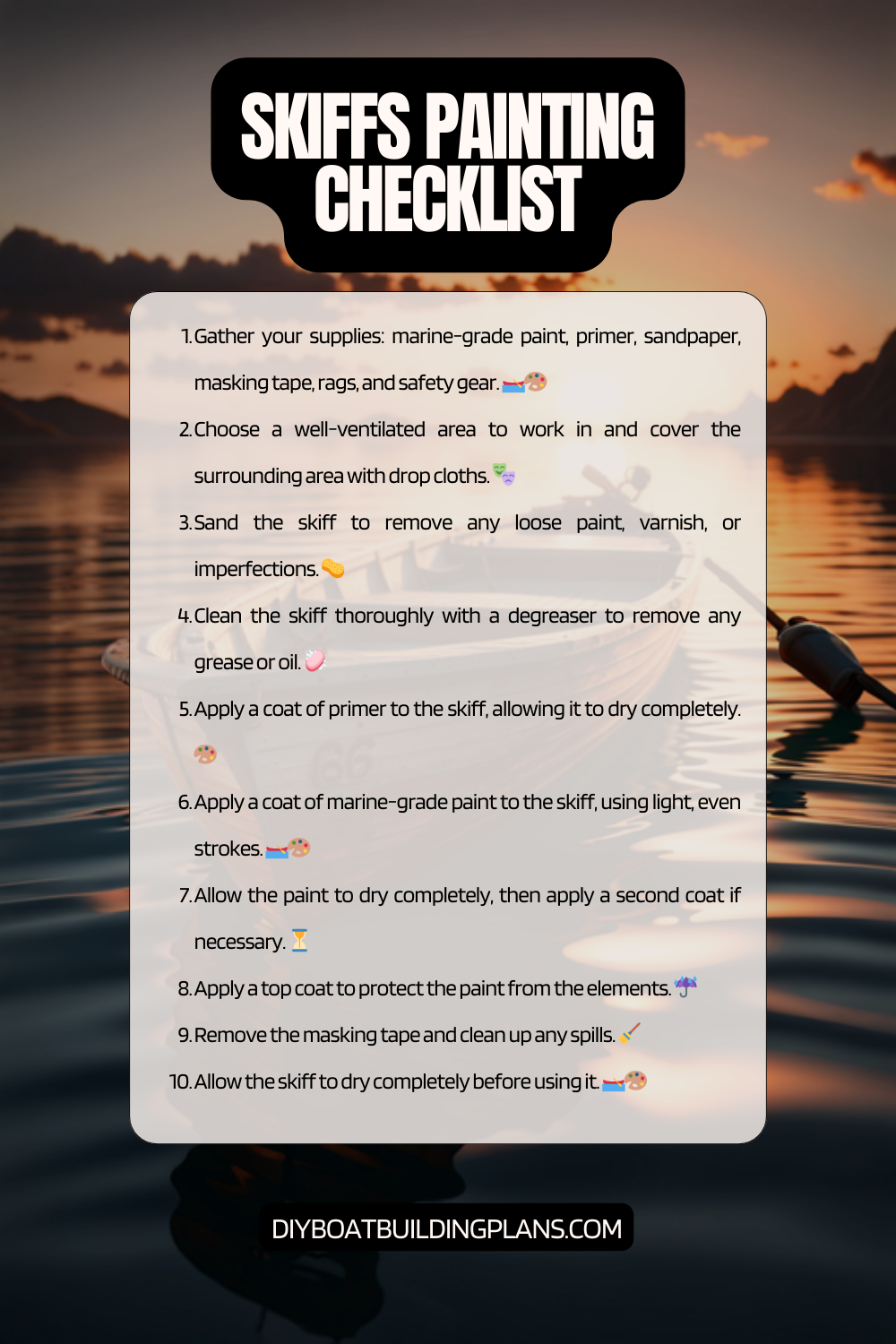Overview of Skiff Painting Tips
Skiff painting is an essential part of maintaining and enhancing the appearance of your boat. Whether you have a brand new skiff or an older one that needs a fresh coat of paint, it’s important to follow the right techniques to achieve a professional-looking finish. In this article, we will explore various tips and tricks for skiff painting, from choosing the right paint to maintaining your skiff’s paint job.
Key Takeaways
- Choose the right paint for your skiff to ensure durability and longevity.
- Properly prepare your skiff for painting by cleaning and sanding the surface.
- Use a spray gun for a smooth and even finish in small areas and tight spaces.
- Consider weather conditions when painting and use appropriate techniques for each situation.
- Maintain your skiff’s paint job by regularly cleaning and touching up any chips or scratches.

Choosing the Right Paint for Your Skiff
When it comes to choosing the right paint for your skiff, there are several options available. One popular choice is marine-grade paint, which is specifically designed to withstand the harsh conditions of being exposed to water, sunlight, and salt. Another option is epoxy paint, which provides excellent durability and resistance to abrasion. Polyurethane paint is also commonly used for skiff painting due to its high gloss finish and UV resistance.
When selecting paint for your skiff, there are a few factors to consider. First, you need to determine whether you want a glossy or matte finish. Glossy finishes tend to be more durable and easier to clean, while matte finishes can provide a more subtle and natural look. Additionally, consider the color options available and choose a paint that complements the overall aesthetic of your skiff. Lastly, take into account the environmental impact of the paint you choose and opt for eco-friendly options whenever possible.
Preparing Your Skiff for Painting
Before you start painting your skiff, it’s crucial to thoroughly clean the surface to ensure proper adhesion of the paint. Begin by removing any loose dirt or debris using a soft brush or sponge. Then, wash the skiff with a mild detergent and water solution, making sure to remove any grease or oil stains. Rinse the skiff thoroughly and allow it to dry completely before proceeding to the next step.
Inspect your skiff for any damages, such as scratches, dents, or cracks, and repair them before painting. Use a marine-grade filler to fill in any imperfections and sand the area smooth once the filler has dried. This step is essential to achieve a flawless finish and prevent further damage to your skiff.
Sanding Techniques for a Smooth Finish
| Sanding Technique | Description | Advantages | Disadvantages |
| Hand Sanding | Sanding by hand using sandpaper or sanding blocks. | Controlled sanding, good for small areas, inexpensive. | Time-consuming, can cause uneven sanding, can be tiring. |
| Power Sanding | Sanding using a power tool such as an orbital sander or belt sander. | Efficient, saves time, good for large areas. | Can be expensive, can cause damage if not used properly, can be noisy. |
| Wet Sanding | Sanding using water to lubricate the sandpaper and reduce dust. | Produces a smooth finish, reduces dust, good for finishing coats. | Can be messy, requires more time and effort, can cause rust if not dried properly. |
| Dry Sanding | Sanding without water or lubrication. | Good for rough sanding, can be done quickly, less messy. | Produces more dust, can cause scratches, not suitable for finishing coats. |
Sanding is a crucial step in skiff painting as it helps create a smooth surface for the paint to adhere to. There are various types of sandpaper available, ranging from coarse to fine grits. Coarse sandpaper, such as 80 or 120 grit, is ideal for removing old paint or rough surfaces. Medium grit sandpaper, around 180 or 220, is suitable for smoothing out imperfections, while fine grit sandpaper, like 320 or 400, is used for achieving a smooth finish.
When sanding your skiff, it’s important to use even and consistent strokes to avoid creating uneven surfaces. Start with a coarse grit sandpaper to remove any old paint or rough areas. Then gradually move to finer grits, making sure to sand in the direction of the grain. Use a sanding block or a sanding sponge for flat surfaces and wrap sandpaper around a dowel or other suitable object for curved areas. After sanding, wipe down the skiff with a tack cloth to remove any dust particles before proceeding with priming.
Applying Primer to Your Skiff
Priming your skiff is an essential step that helps improve paint adhesion and provides an extra layer of protection against corrosion and damage. Primer also helps create a smooth surface for the paint and enhances its durability. Skipping this step can result in poor paint adhesion, uneven finish, and reduced longevity of the paint job.
There are different types of primers available for skiff painting, including epoxy primers, etching primers, and self-etching primers. Epoxy primers are known for their excellent adhesion and corrosion resistance. Etching primers are designed to provide a strong bond to bare metal surfaces, while self-etching primers are specifically formulated for aluminum surfaces. Choose a primer that is compatible with the type of paint you will be using and follow the manufacturer’s instructions for application.
Tips for Painting Small Areas and Tight Spaces
When it comes to painting small areas and tight spaces on your skiff, choosing the right brush is crucial. Look for a brush with a smaller size and fine bristles that can provide better control and precision. Synthetic brushes are often recommended for marine painting as they are more resistant to water and solvents.
To achieve a professional finish on small areas, it’s important to use proper techniques. Start by applying thin coats of paint, using smooth and even strokes. Avoid overloading the brush with paint as it can lead to drips or uneven application. For tight spaces, consider using a small foam roller or a sponge brush for better maneuverability. Take your time and be patient when painting small areas to ensure a flawless finish.
Using a Spray Gun for Skiff Painting
Using a spray gun for skiff painting can offer several advantages. Firstly, it allows for faster application, especially on larger surfaces, compared to using brushes or rollers. Spray guns also provide a more even and consistent coat of paint, resulting in a smoother finish. Additionally, they can reach tight corners and crevices more easily, ensuring complete coverage.
When using a spray gun, it’s important to follow proper techniques to achieve the best results. Start by practicing on a scrap piece of material to get a feel for the spray pattern and adjust the settings accordingly. Maintain a consistent distance from the skiff while spraying, usually around 6-8 inches, to ensure even coverage. Apply thin coats of paint, allowing each coat to dry before applying the next. Proper ventilation is crucial when using a spray gun, so make sure to work in a well-ventilated area or wear a respirator.
Painting in Different Weather Conditions
The weather conditions can greatly affect the outcome of your skiff painting project. Ideally, you should paint your skiff on a dry and mild day with temperatures between 50-85 degrees Fahrenheit. Avoid painting in direct sunlight or high humidity as it can cause the paint to dry too quickly or not adhere properly.
If you find yourself painting in hot and humid weather, there are a few tips to keep in mind. Firstly, try to paint early in the morning or late in the afternoon when temperatures are cooler. Avoid painting during peak heat hours as it can cause the paint to dry too quickly and result in an uneven finish. Additionally, consider using a slower drying paint or adding a paint conditioner to extend the drying time. Proper ventilation is crucial in humid conditions, so make sure to open windows or use fans to improve air circulation.
How to Achieve a Glossy or Matte Finish
To achieve a glossy finish on your skiff, it’s important to choose the right type of paint and apply it correctly. Opt for high-gloss marine-grade paints that are specifically formulated for boats. Apply thin coats of paint using a brush, roller, or spray gun, allowing each coat to dry before applying the next. Sand the surface lightly between coats to remove any imperfections and ensure a smooth finish. Finally, apply a clear coat or marine-grade varnish to enhance the glossiness and provide additional protection.
If you prefer a matte finish for your skiff, there are a few techniques you can use. Start by choosing a matte or satin paint that is specifically designed for boats. Apply thin coats of paint using a brush or roller, allowing each coat to dry completely before applying the next. Avoid sanding between coats as it can create a smoother surface and reduce the matte effect. Once the final coat has dried, apply a matte clear coat or wax to protect the paint and enhance its appearance.
Download over 500 Boat Plans. Click on the link below.
-->Click Here<--
Maintaining Your Skiff’s Paint Job
Regular cleaning and waxing are essential for maintaining the longevity and appearance of your skiff’s paint job. Wash your skiff with a mild detergent and water solution regularly to remove dirt, salt, and other contaminants. Avoid using abrasive cleaners or brushes that can damage the paint. After washing, apply a marine-grade wax or polish to protect the paint from UV rays and provide a glossy finish.
Over time, your skiff’s paint may develop scratches or chips due to normal wear and tear. It’s important to address these issues promptly to prevent further damage. Start by cleaning the affected area and sanding it lightly to create a smooth surface. Then, apply touch-up paint using a small brush or sponge, following the manufacturer’s instructions. Allow the touch-up paint to dry completely before applying a clear coat or wax to blend it with the surrounding area.
Common Mistakes to Avoid When Painting Your Skiff
One common mistake when painting a skiff is rushing the process. Painting requires patience and attention to detail. Take your time to properly prepare the surface, apply thin coats of paint, and allow each coat to dry before proceeding. Rushing can lead to uneven application, drips, or other imperfections that can affect the overall finish.
Another mistake to avoid is not using enough paint. Applying thin coats is important, but it’s equally important to ensure proper coverage. Insufficient paint can result in a patchy or uneven finish. Follow the manufacturer’s instructions regarding the recommended number of coats and apply enough paint to achieve full coverage.
Skiff Painting Checklist

Conclusion – Skiff Painting Tips
In conclusion, skiff painting is a meticulous process that requires careful preparation, proper techniques, and attention to detail. By choosing the right paint, preparing your skiff adequately, and following the recommended steps for sanding, priming, and painting, you can achieve a professional-looking finish that will enhance the appearance and longevity of your skiff. Additionally, regular maintenance and avoiding common mistakes will help preserve the beauty of your skiff’s paint job for years to come. So take your time, follow these tips, and enjoy the rewarding experience of painting your skiff.
FAQs – Skiff Painting Tips
What is skiff painting?
Skiff painting is the process of applying paint or other coatings to a skiff, which is a small, flat-bottomed boat typically used for fishing or transportation in shallow waters.
Why is skiff painting important?
Skiff painting is important for several reasons. It helps protect the boat from the elements, such as sun, saltwater, and moisture, which can cause damage over time. It also enhances the boat’s appearance and can increase its resale value.
What are some tips for preparing a skiff for painting?
Some tips for preparing a skiff for painting include cleaning the surface thoroughly, sanding any rough spots or old paint, filling in any cracks or holes with putty, and masking off any areas that should not be painted.
What types of paint are best for skiff painting?
The best types of paint for skiff painting depend on the specific needs of the boat and the preferences of the owner. Some popular options include marine-grade enamel, epoxy paint, and polyurethane paint.
How should I apply paint to a skiff?
When applying paint to a skiff, it is important to follow the manufacturer’s instructions carefully. Generally, it is best to apply several thin coats of paint rather than one thick coat, and to use a high-quality brush or roller for a smooth finish. It is also important to allow each coat to dry completely before applying the next.
How can I maintain the paint on my skiff?
To maintain the paint on a skiff, it is important to keep the boat clean and dry, and to avoid exposing it to harsh elements such as direct sunlight or saltwater. Regularly inspecting the paint for signs of wear or damage and touching up any areas as needed can also help prolong the life of the paint job.



